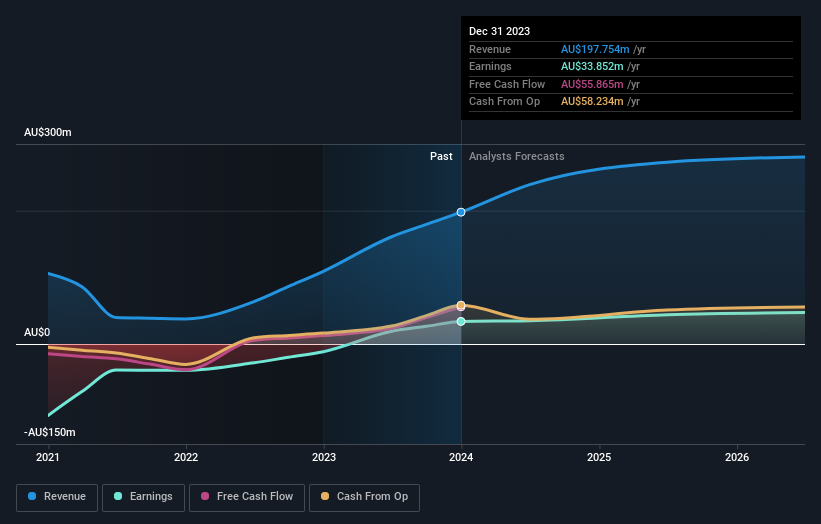Key Insights
-
The considerable ownership by individual investors in Helloworld Travel indicates that they collectively have a greater say in management and business strategy
-
The top 9 shareholders own 51% of the company
To get a sense of who is truly in control of Helloworld Travel Limited (ASX:HLO), it is important to understand the ownership structure of the business. We can see that individual investors own the lion’s share in the company with 48% ownership. In other words, the group stands to gain the most (or lose the most) from their investment into the company.
Private companies, on the other hand, account for 27% of the company’s stockholders.
Let’s delve deeper into each type of owner of Helloworld Travel, beginning with the chart below.
See our latest analysis for Helloworld Travel
What Does The Institutional Ownership Tell Us About Helloworld Travel?
Institutional investors commonly compare their own returns to the returns of a commonly followed index. So they generally do consider buying larger companies that are included in the relevant benchmark index.
We can see that Helloworld Travel does have institutional investors; and they hold a good portion of the company’s stock. This implies the analysts working for those institutions have looked at the stock and they like it. But just like anyone else, they could be wrong. It is not uncommon to see a big share price drop if two large institutional investors try to sell out of a stock at the same time. So it is worth checking the past earnings trajectory of Helloworld Travel, (below). Of course, keep in mind that there are other factors to consider, too.
Helloworld Travel is not owned by hedge funds. Sintack Pty Ltd. is currently the company’s largest shareholder with 13% of shares outstanding. Meanwhile, the second and third largest shareholders, hold 11% and 9.0%, of the shares outstanding, respectively. Additionally, the company’s CEO Andrew Burnes directly holds 6.5% of the total shares outstanding.
On further inspection, we found that more than half the company’s shares are owned by the top 9 shareholders, suggesting that the interests of the larger shareholders are balanced out to an extent by the smaller ones.
Researching institutional ownership is a good way to gauge and filter a stock’s expected performance. The same can be achieved by studying analyst sentiments. There are plenty of analysts covering the stock, so it might be worth seeing what they are forecasting, too.
Insider Ownership Of Helloworld Travel
The definition of an insider can differ slightly between different countries, but members of the board of directors always count. The company management answer to the board and the latter should represent the interests of shareholders. Notably, sometimes top-level managers are on the board themselves.
Most consider insider ownership a positive because it can indicate the board is well aligned with other shareholders. However, on some occasions too much power is concentrated within this group.
Our most recent data indicates that insiders own a reasonable proportion of Helloworld Travel Limited. Insiders own AU$66m worth of shares in the AU$456m company. This may suggest that the founders still own a lot of shares. You can click here to see if they have been buying or selling.
General Public Ownership
The general public– including retail investors — own 48% stake in the company, and hence can’t easily be ignored. While this group can’t necessarily call the shots, it can certainly have a real influence on how the company is run.
Private Company Ownership
It seems that Private Companies own 27%, of the Helloworld Travel stock. Private companies may be related parties. Sometimes insiders have an interest in a public company through a holding in a private company, rather than in their own capacity as an individual. While it’s hard to draw any broad stroke conclusions, it is worth noting as an area for further research.
Next Steps:
I find it very interesting to look at who exactly owns a company. But to truly gain insight, we need to consider other information, too. Case in point: We’ve spotted 2 warning signs for Helloworld Travel you should be aware of.
If you would prefer discover what analysts are predicting in terms of future growth, do not miss this free report on analyst forecasts.
NB: Figures in this article are calculated using data from the last twelve months, which refer to the 12-month period ending on the last date of the month the financial statement is dated. This may not be consistent with full year annual report figures.
Have feedback on this article? Concerned about the content? Get in touch with us directly. Alternatively, email editorial-team (at) simplywallst.com.
This article by Simply Wall St is general in nature. We provide commentary based on historical data and analyst forecasts only using an unbiased methodology and our articles are not intended to be financial advice. It does not constitute a recommendation to buy or sell any stock, and does not take account of your objectives, or your financial situation. We aim to bring you long-term focused analysis driven by fundamental data. Note that our analysis may not factor in the latest price-sensitive company announcements or qualitative material. Simply Wall St has no position in any stocks mentioned.












